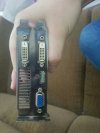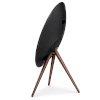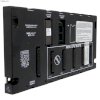MSI Radeon R9 270 Gaming OC và Sapphire Dual-X R9 270 OC Video Card
Vào thời điểm cuối năm 2013, Advanced Micro Devices (AMD) đã khiến cho thị trường sôi sục khi liên tục tung ra các mẫu card đồ họa mới. Hôm này chúng ta sẽ cùng xem xét card đồ họa Radeon R9 270, chiếc card này được bán với mức giá đề nghị 179.99$. Đây là chiếc card video thứ sáu trong series Radeon R7 và R9 mà AMD đã cho ra mắt trong tháng 11 năm 2013. Điểm đáng thú vị ở chiếc card “mới’ này là mức giá của nó, mặc dù thuộc series R9 cao cấp nhưng nó chỉ có mức giá khoảng 179$. Trong khi đó, chiếc card này vẫn được trang bị GPU Pitcarin đúng như loại được trang bị cho AMD Radeon R9 270X!
AMD Radeon R9 270 có khá nhiều điểm tương tự như Radeon R9 270X nhưng nó có tốc độ xung nhịp GPU thấp hơn và yêu cầu công suất nhỏ hơn. AMD Radeon R9 270X yêu cầu công suất 180 Watts, được cấp thông qua hai kết nối nguồn PCIe 6-pin. AMD Radeon R9 270 mới chỉ yêu cầu nguồn điện 150 Watts thông qua kết nối nguồn PCIe 6-pin duy nhất. Đây là một điểm rất đáng chú ý bởi các hệ thống cũ và các hệ thống mua từ các cửa hàng thông thường thưởng chỉ có thể xử lý một card đồ họa rời yêu cầu nguồn điện khiêm tốn.
AMD Radeon R9 270X có tốc độ xung nhịp 1050MHz trên lõi và tốc độ xung nhịp 1400MHz trên bộ nhớ GDDR5. Còn chiếc AMD Radeon R9 270 mới có ốc độ xung nhịp 925MHz trên lõi và tốc độ xung nhịp 1400MHz trên bộ nhớ GDDR5. Các thông số kể trên cho thấy tốc độ xung nhịp lõi của R9 270 thấp hơn 75MHzm, tương đương giảm 7% tốc độ so với R9 270X. Việc giảm tốc độ xung nhịp đồng nghĩa với việc hiệu suất tính toán bị giảm từ 2.69TFLOPS (nghìn tỷ phép tính mỗi giây) xuống còn 2,37 TFLOPS. Đây là mức giảm 11.9 phần trăm, do việc giảm tốc độ xung nhịp và công suất của bảng điện chắc chắn sẽ ảnh hưởng đến hiệu năng chơi game nên chiếc card này có giá thấp hơn 20$.
Chúng tôi không nhận được Radeon R9 270 reference card từ AMD, tuy nhiên chúng tôi đã tìm thấy một cặp card từ những người bạn của mình ở MSI và Sapphire. MSI đã gửi cho chúng tôi card đồ họa Radeon R9 270 Gaming OC 2GB (ký hiệu R9 270 GAMING 2G) và Sapphire gửi cho chúng tôi card đồ họa Dual-X R9 270 2G GDDR5 with Boost (ký hiệu 11220-00-40G).
Cả hai chiếc card đồ họa Radeon R9 270 mà chúng tôi nhận được từ MSI và Sapphire đều đã được ép xung. MSI R9 270 Gaming có tốc độ xung nhịp 975MHz, cao hơn 50Hz so với Radeon R9 270 reference card và Sapphire Dual-X OC có tốc độ xung nhịp cao hơn 20MHz. Đây là mức ép xung khá thấp, nguyên nhân là bởi vì khả năng ép xung bị giới hạn bởi nguồn cấp điện và chiếc card này chỉ được cấp điện thông qua kết nối nguồn PCIe 6-pin duy nhất.
Cả hai chiếc card đồ họa AMD Raedeon R9 270 này đều có hệ thống làm mát GPU đôi với hai quạt làm mát cho GPU và bộ nhớ. Cả hai công ty đã tùy chỉnh PCB trên chiếc card Radeon R9 270 của mình. Sapphire Dual-X R9 270 OC có chiếu dài 7.8 inch, cộng thêm phần không gian tăng thêm bởi tấm bảo vệ quạt làm mát thì nó có tổng chiều dài là 8.25 inch. MSI R9 270 Gaming thì có chiều dài 10 inch (chiều dài PCB là 8.75 inch nhưng tấm bảo vệ quạt làm mát mở rộng sang cả hai bên của PCB khiến chiều dài PCB tăng thêm đáng kể).
Về phương diện các cổng kết nối đầu ra video, bạn có thể tìm thấy một cặp kết nối DVI (DVI-I và DVI-D), cổng kết nối Display Port và cổng kết nối HDMI. Cả hai chiếc card đều để dành không giản để không khí nóng có thể xả ra ngoài, tuy nhiên có vẻ như chiếc card của Sapphire đã được mở rộng cửa thông khí để giảm tiếng ổn và cải thiện luồng không khí để làm mát tốt hơn.
Cả hai chiếc card đồ họa này đều được trang bị hệ thống làm mát GPU với hai ống dẫn nhiệt bằng đồng, tuy nhiên kích thước của chúng khác nhau. Chiếc card của MIS sử dụng một ống dẫn nhiệt 6mm và một ống dẫn nhiệt 8mm, trong khí đó card của Sapphire sử dụng hai ống dẫn nhiệt 8mm. Đường kính cánh quạt thực tế trên card của MSI là 95 mm và trên card Sapphire Dual-X là chỉ 74 mm. Bạn có thể nhận thấy điểm thú vị là MSI sử dụng quạt làm mát có kích thước lớn hơn trong khi đó lại sử dụng ống dẫn nhiệt nhỏ hơn còn Sapphire thì ngược lại, sử dụng ống dẫn nhiệt lớn hơn với quạt làm mát nhỏ hơn. Cả hai chiếc card này đề được trang bị cổng kết nối AMD CrossFire ở phía cạnh trên của PCB để bạn có thể thiết lập hệ thống sử dụng nhiều GPU cùng một lúc.
Cả hai chiếc card đồ họa này đều chỉ có một kết nối nguồn điện 6-pin PCI Express duy nhất được đặt ở phía gần cuối của card. MSI R9 270 Gaming OC đặt nó ở phía trên gần cuối card còn Sapphire Dual-X R9 270 đặt nó ở vị trí cuối cùng. Cả MSI và Sapphire đều khuyên người sử dụng nên dùng một nguồn cấp điện 500W hoặc lớn hơn thông qua kết nối điện 6-pin 75W để cung cấp điện đầy đủ cho chiếc card của họ hoạt động tốt nhất. Nếu bạn muốn chạy AMD CrossFire, nguồn cấp điện được đề nghị có công suất lớn hơn 600W với hai kết nối điện PCIe 75 Watt.
| Display Support |
supports up to 3 display monitor(s) without DisplayPort
4 x Maximum Display Monitor(s) support
|
| Output |
1 x HDMI (with 3D)
1 x DisplayPort 1.2
1 x Dual-Link DVI-D
1 x Dual-Link DVI-I
|
| GPU |
1020 (Boost:1070) MHz Core Clock
28 nm Chip
1280 x Stream Processors
|
| Video Memory |
2048 MB Size
256 -bit GDDR5
5600 MHz Effective
|
| Dimension |
228(L)X109(W)X35(H) mm Size.
2 x slot
|
| Software |
Driver CD
SAPPHIRE TriXX Utility
|
| Accessory |
CrossFire™ Bridge Interconnect Cable
DVI to VGA Adapter
6 PIN to 4 PIN Power Cable x 2
HDMI 1.4a high speed 1.8 meter cable(Full Retail SKU only)
|
 Overview Overview |
 |
HDMI (with 3D)
 Support for Deep Color, 7.1 High Bitrate Audio, and 3D Stereoscopic, ensuring the highest quality Blu-ray and video experience possible from your PC. Support for Deep Color, 7.1 High Bitrate Audio, and 3D Stereoscopic, ensuring the highest quality Blu-ray and video experience possible from your PC.
|
|
 |
DisplayPort 1.2
Doubling the effective bandwidth of previous DisplayPort implementations, DisplayPort 1.2 now includes support for Multi-Stream, allowing you to drive up to four separate monitors from a single DisplayPort 1.2 connector (requires DP1.2 monitors or Multi-Stream compatible hub), Stereoscopic 3D monitor support and adds support for high quality, lossless, 7.1 channel audio formats.
|
|
 |
Dual-Link DVI-D
Equipped with the most popular Dual Link DVI (Digital Visual Interface), this card is able to display ultra high resolutions of up to 2560 x 1600 at 60Hz.
|
|
 |
Dual-Link DVI-I
Equipped with the most popular Dual Link DVI (Digital Visual Interface), this card is able to display ultra high resolutions of up to 2560 x 1600 at 60Hz.
|
|
 |
Advanced GDDR5 Memory Technology
GDDR5 memory provides twice the bandwidth per pin of GDDR3 memory, delivering more speed and higher bandwidth.
|
|
 |
AMD Stream Technology
Accelerate the most demanding applications with AMD Stream technology and do more with your PC. AMD Stream Technology allows you to use the teraflops of compute power locked up in your graphics processer on tasks other than traditional graphics such as video encoding, at which the graphics processor is many, many times faster than using the CPU alone.
|
|
 |
AMD Avivo HD (DVD/HD-DVD/Blu-ray Playback)
Watch the hottest Blu-ray movies or other HD content at full 1080p display resolution and beyond and enjoy a more feature rich experience with enhanced Unified Video Decoder(UVD)
|
|
 |
AMD CrossFireX™ Multi-GPU Technology
Triple or Quadruple gaming power with AMD CrossFireX™ Multi-GPU Technology.AMD CrossFireX technology supports up to four graphics cards to be used in a single system.
|
|
 |
AMD HD3D Technology
Enjoy the most immersive experience possible with full support for High Definition Stereoscopic 3D, a technique that presents 2D images (movies, games, photos) in a format that creates the illusion of three-dimensional depth when using compatible 3D displays / glasses / software.
|
|
 |
28 nm GCN (Graphic Core Next) Architecture
The new 28nm GCN Architecture’s more efficient process technology puts more transistors in less space, enabling a dramatic increase in processing power
|
|
 |
PCI Express 3.0
PCI-Express 3.0 delivers double the bandwidth per lane of PCIe Gen 2 for faster GPU (GPU communication-up to 16GB/sec in each direction), maximizing the performance from your GPU when paired with the latest platforms.
|
|
 |
AMD Eyefinity 2.0
The next generation of AMD Eyefinity technology is here, featuring all-new support for stereo 3D, universal bezel compensation and brand new display configurations. Face it: the best just got better: The enhancements for AMD Radeon HD7000 series include: Stereo 3D-multi-display stereoscopic 3D support via DisplayPort 16K X 16K maximum display group resolution-output up to 268 megapixels per GPU.

*To support 3 displays, one of the monitors has to support DisplayPort
*With Sapphire Flex Technology, this requirement will be no necessary
Learn more about Sapphire Flex Technology→http://www.sapphiretech.com/Flex/FleX_Eng_home.html
**When running Microsoft Windows XP, Eyefinity technlogy supports a maximum of 2 displays.
|
|
 |
SAPPHIRE Dual-X Cooling Technology
Famous for our exclusive cooling solutions like the award winning Vapor Chamber Cooling technology - Vapor-X, SAPPHIRE's reputation for innovative excellence continues to grow with the introduction of our new dual-extractor technology - Dual-X. Dual-X is a highly efficient multi-heatpipe cooler with dual fans that provide quiet and very cool operation during normal operating conditions, and superb cooling performance even under extreme load.
|
|
 |
DirectX® 12
The tessellation performance on AMD Radeon R7/ R9 series is up to 2X faster than the previous generation, and DirectCompute performance is also faster to accelerate advanced post-processing, filtering, and anti-aliasing techniques. Direct X12 games has never looked this good.
* Based on preliminary DirectX 12 specifications as of July, 2014, AMD’s GCN-based products are expected to support DirectX 12 upon its release. The DirectX 12 specification and support for it are subject to change without notice.
|
|
 |
OpenGL 4.3
OpenGL 4.3 improves the GPU efficiency by improving the shader process operation and capturing GPU tessellated geometry. The process of modifying an arbitrary subset of compress texture is also simplified. The memory management in handling shaders is more efficient as well.
|
|
 |
Mantle

Properly enabled games will reach new heights of performance by speaking the language of Graphics Core Next architecture.
|
|
 |
AMD Catalyst Control Center™
The AMD Catalyst Control Center™ software application gives you complete control over the performance and visual quality of your SAPPHIRE AMD Radeon™ based graphics card allowing for the best experience on your PC.
|
|
 |
Dolby® TrueHD and DTSHD Master Audio™ Support
Support for copy protected, high bandwidth, 7.1 channel surround sound over HDMI. Get a fully immersive, high definition audio experience with the latest Blu-ray movies. (Requires a DVI to HDMI dongle on some models, an HD capable monitor and a Blu-ray drive)
|
|
 |
Anti-aliasing features
Supports advanced AA (Anti-aliasing) features to maximise your enjoyment of high definition gaming.
- Multi-sample anti-aliasing (2, 4 or 8 samples per pixel)
- Up to 24x Custom Filter Anti-Aliasing (CFAA) for superior quality
- Adaptive super-sampling and multi-sampling
- Gamma correct
- Super AA (AMD CrossFireX™configurations only)
- All anti-aliasing features compatible with HDR rendering
|
|
 |
TriXX Utility
TriXX helps users to get the optimum performance from compatible SAPPHIRE graphics cards in any application by allowing them to monitor, tune and save different settings of key parameters for the card.
|
|
 |
Enhanced Unified Video Decoder 3 (UVD 3)
Watch the hottest Blu-ray movies or other HD content at full 1080p (and beyond !) display resolution. Enjoy a feature rich video experience with enhanced Unified Video Decoder 3 (UVD 3), offloading the bulk of the video decoding tasks from the CPU to the GPU allowing for a cooler, quieter and more balanced system.
|
|
 |
Microsoft Office 2010
Take advantage of improved picture and media editing capabilities in Office 2010 as well as edit and share your content in real time.
See more, and get more done. Enhanced productivity with accelerated GPU processing for Office applications.
|
|
 |
Windows® 7 support
WHQL (Windows Hardware Quality Labs) Certified drivers and logos are available for all SAPPHIRE HD2000, HD3000, HD4000 and HD5000 series cards ensuring compatibility and reliability with Microsoft Windows 7.
|
|
 |
AMD App Acceleration
AMD App Acceleration is a set of technologies designed to improve video quality and enhance application performance. Full enablement of some features requires support for OpenCL, DirectCompute or DirectX Video Acceleration (DXVA).
|
|
 |
AMD PowerPlay with ZeroCore Power Technology
AMD PowerPlay is a power management technology in response to the GPU loading, AMD PowerPlay automatically manages the power consumption.
AMD ZeroCore Power technology allows your AMD Radeon™ GPU to consume virtually no power when in idle state5. When used with AMD CrossFire™ technology, it shuts down additional GPUs when they’re not in use.
|
|
 |
AMD HD Media Accelerator
AMD HD Media Accelerator has been designed to help optimize and dramatically improve video playback on your computer by taking advantage of hardware video acceleration from your AMD Radeon GPU. With full 3D stereoscopic decode you can enjoy it all in 3D. AMD HD Media Accelerator speeds up the decode of one 1080p and one 1080i HD video streams simultaneously by hardware, and the new hardware encodes/transcoder processes your media content faster than ever!
|
|
 |
Cutting-edge Quad HD display support (4K Support)
The display resolution is quadrupled to the resolution of 4KX2K( 4096X2160 ) from the outputs of DisplayPort 1.2 and HDMI.
|
|
 |
AMD PowerTune technology (with Boost)
AMD PowerTune technology (with Boost) is a breakthrough technology that sets an entirely new direction for maximum performance at TDP. It allows the GPU to be designed with higher engine clock speeds which can be applied on the broad set of applications that have thermal headroom.
In HD 7900 series, AMD PowerTune technology enables intelligent power monitoring to enable higher clock speeds and better performance in your favorite games
|
|
 |
Windows® 8/8.1 support
WHQL (Windows Hardware Quality Labs) Certified drivers and logos are available for SAPPHIRE cards ensuring compatibility and reliability with Microsoft Windows 8/8.1.
|
|
































